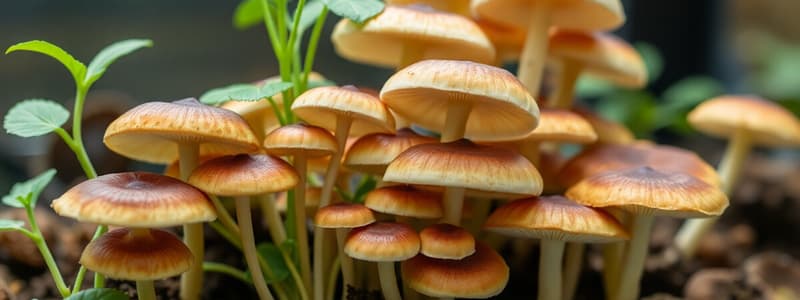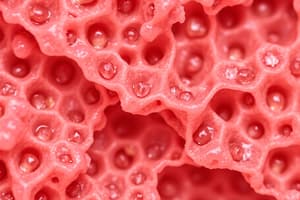Podcast
Questions and Answers
Roots that have no main section but instead spread out, forming a tangled mass are called ______ roots.
Roots that have no main section but instead spread out, forming a tangled mass are called ______ roots.
fibrous
The long, straight shaft of a long bone is known as the ______.
The long, straight shaft of a long bone is known as the ______.
diaphysis
Mosses and liverworts are classified as ______.
Mosses and liverworts are classified as ______.
bryophytes
Trees that lose their leaves in autumn and remain bare in the winter are called ______ trees.
Trees that lose their leaves in autumn and remain bare in the winter are called ______ trees.
Plants that reproduce by seeds formed in cones are known as ______.
Plants that reproduce by seeds formed in cones are known as ______.
The two broad divisions of the skeletal system are the axial skeleton and the ______ skeleton.
The two broad divisions of the skeletal system are the axial skeleton and the ______ skeleton.
An organism that obtains its nutrition from dead organisms is referred to as a ______.
An organism that obtains its nutrition from dead organisms is referred to as a ______.
Yeasts and mildew are classified as ______ fungi.
Yeasts and mildew are classified as ______ fungi.
Layering, grafting, and budding are methods of ______ propagation.
Layering, grafting, and budding are methods of ______ propagation.
In the scientific name Ornithorhynchus anatinus, Ornithorhynchus refers to the ______.
In the scientific name Ornithorhynchus anatinus, Ornithorhynchus refers to the ______.
Muscles that allow you to pull your shoulders back and help pull your head up are the ______ muscles.
Muscles that allow you to pull your shoulders back and help pull your head up are the ______ muscles.
Plants that reproduce by seeds formed in cones are classified as ______.
Plants that reproduce by seeds formed in cones are classified as ______.
The skeletal system has two main parts: the axial skeleton and the ______ skeleton.
The skeletal system has two main parts: the axial skeleton and the ______ skeleton.
An organism that derives its nutrients from decomposing organic matter is called a ______.
An organism that derives its nutrients from decomposing organic matter is called a ______.
Flashcards are hidden until you start studying
Study Notes
Fibrous Roots
- Roots that have no main section but instead spread out, forming a tangled mass are called fibrous roots.
Diaphysis
- The long, straight shaft of a long bone is known as the diaphysis.
Bryophytes
- Mosses and liverworts are classified as Bryophytes.
Deciduous Trees
- Trees that lose their leaves in autumn and remain bare in the winter are called deciduous trees.
Gymnosperms
- Plants that reproduce by seeds formed in cones are known as gymnosperms.
Appendicular Skeleton
- The two broad divisions of the skeletal system are the axial skeleton and the appendicular skeleton.
Saprophytes
- An organism that obtains its nutrition from dead organisms is referred to as a saprophyte.
Fungi
- Yeasts and mildew are classified as fungi.
Vegetative Propagation
- Layering, grafting, and budding are methods of vegetative propagation.
Genus
- In the scientific name Ornithorhynchus anatinus, Ornithorhynchus refers to the genus.
Trapezius
- Muscles that allow you to pull your shoulders back and help pull your head up are the trapezius muscles.
Gymnosperms
- Plants that reproduce by seeds formed in cones are classified as gymnosperms.
Appendicular Skeleton
- The skeletal system has two main parts: the axial skeleton and the appendicular skeleton.
Saprophytes
- An organism that derives its nutrients from decomposing organic matter is called a saprophyte.
Studying That Suits You
Use AI to generate personalized quizzes and flashcards to suit your learning preferences.




